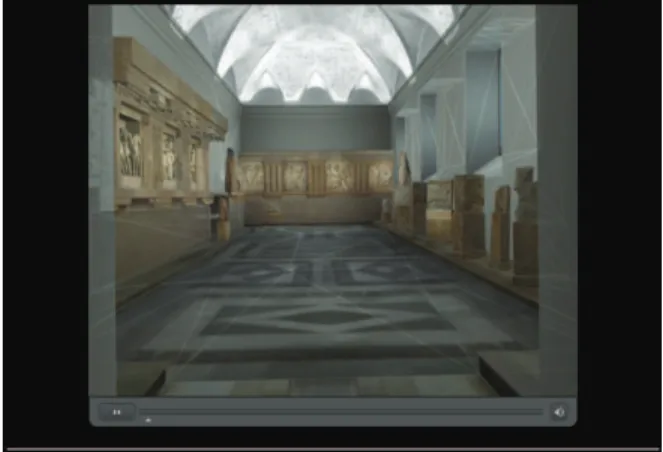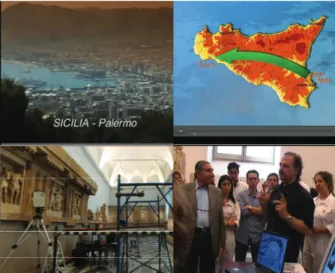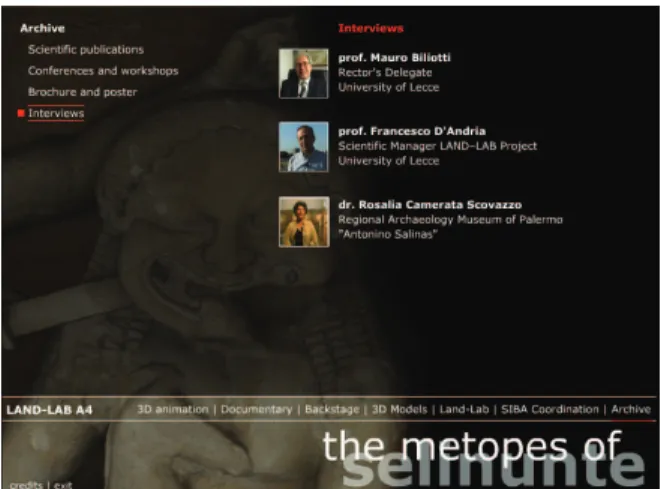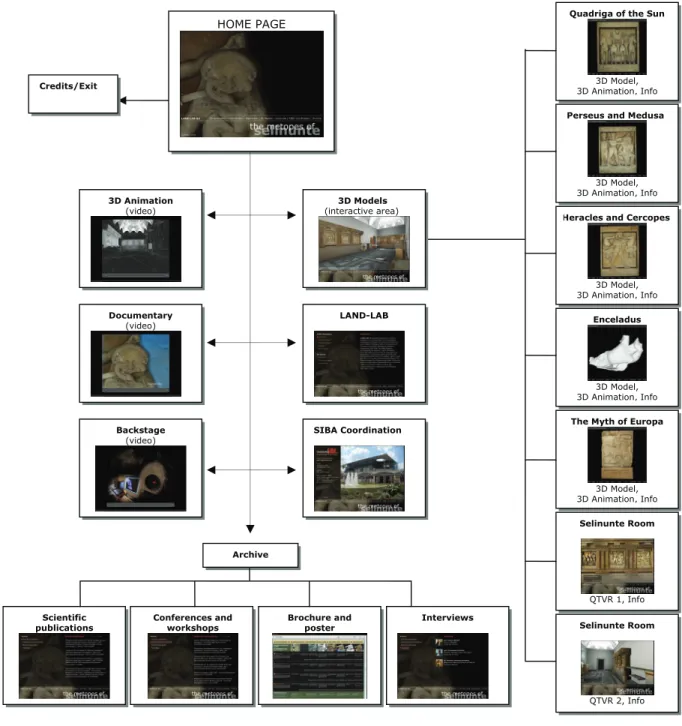Publisher’s version / Version de l'éditeur:
Vous avez des questions? Nous pouvons vous aider. Pour communiquer directement avec un auteur, consultez la première page de la revue dans laquelle son article a été publié afin de trouver ses coordonnées. Si vous n’arrivez pas à les repérer, communiquez avec nous à PublicationsArchive-ArchivesPublications@nrc-cnrc.gc.ca.
Questions? Contact the NRC Publications Archive team at
PublicationsArchive-ArchivesPublications@nrc-cnrc.gc.ca. If you wish to email the authors directly, please see the first page of the publication for their contact information.
https://publications-cnrc.canada.ca/fra/droits
L’accès à ce site Web et l’utilisation de son contenu sont assujettis aux conditions présentées dans le site LISEZ CES CONDITIONS ATTENTIVEMENT AVANT D’UTILISER CE SITE WEB.
The 21st International CIPA: The International Committee for Architectural
Photogrammetry Symposium [Proceedings], 2007
READ THESE TERMS AND CONDITIONS CAREFULLY BEFORE USING THIS WEBSITE. https://nrc-publications.canada.ca/eng/copyright
NRC Publications Archive Record / Notice des Archives des publications du CNRC :
https://nrc-publications.canada.ca/eng/view/object/?id=d928c857-aff7-4766-bbd3-87c6b7f55eee
https://publications-cnrc.canada.ca/fra/voir/objet/?id=d928c857-aff7-4766-bbd3-87c6b7f55eee
NRC Publications Archive
Archives des publications du CNRC
This publication could be one of several versions: author’s original, accepted manuscript or the publisher’s version. / La version de cette publication peut être l’une des suivantes : la version prépublication de l’auteur, la version acceptée du manuscrit ou la version de l’éditeur.
Access and use of this website and the material on it are subject to the Terms and Conditions set forth at
The metopes of Selinunte: presentation of the interactive CD-ROM
Beraldin, Jean-Angelo; Valzano, V.; Bandiera, A.
The Metopes of Selinunte: Presentation of
the Interactive CD-ROM *
Beraldin, J.-A., Valzano, V., and Bandiera, A.
2007
* 21st International CIPA - The International Committee for Architectural
Photogrammetry Symposium. Athens Greece. October 1-6, 2007. NRC
49361.
Copyright 2007 by
National Research Council of Canada
Permission is granted to quote short excerpts and to reproduce figures and tables from this report, provided that the source of such material is fully acknowledged.
THE METOPES OF SELINUNTE: PRESENTATION OF THE INTERACTIVE CD-ROM
J.-A. Beraldin a, *, V. Valzano b, A. Bandiera b
a
IIT-VIT, National Research Council Canada, Ottawa, Ont, K1A 0R6 Canada
b
SIBA, Università del Salento, 73100 Lecce, Italy – virginia.valzano@unile.it
Commission V, WG V/2-4KEY WORDS: 3D scanning, texture mapping, interactive 3D, video, renderings, CD-ROM
ABSTRACT:
This paper describes the content and the rational of a CD-ROM that brings both the history and the technology enthusiast to a new level of cognition about Western European history. This bilingual (Italian/English) digital document allows the visitor access to historical information about the Metopes of Selinunte and the temples remains that are tributary of a larger and impressive archaeological complex of Selinunte. A straightforward and convivial navigation through the menus provides a multitude of information in the form of video, images, renderings, three-dimensional models created from reality, historical and scientific articles, and texts that cover the many facets of this archaeological site. Features were programmed in Macromedia DirectorTM to embellish and ease the navigation through the multimedia information that might in some cases frighten novice users of this new type of digital content. Special attention was invested in using spatial information effectively in order to facilitate the understanding of the artefacts displayed in the museum room. A documentary, a backstage movie, a 3D animation, a number of interviews with experts and interactive windows with the virtualized sculptures are fundamental to this rich-media cultural product.
* angelo.beraldin@nrc-cnrc.gc.ca
1. INTRODUCTION TO THE CONTEXT 1.1 Why a CD-ROM to deliver digital cultural content in a connected world?
With an increasing number of people that consider the Internet as more than a plain source of information but rather a link to others in a given community and a way to allow them to experience and interact with digital content (CH, 2005), why should we consider a CD-ROM for the Selinunte project (LandLab, 2003) (see CD-ROM cover on Figure 1)?
Figure 1. Front Cover of CD-ROM: le metope di Selinunte.
To answer this question one can look at a study conducted in Canada in the late ‘90. Most museums surveyed did not recover the full costs of CD-ROM production and development. Only a few museums have made modest returns. Some even experienced difficulties in recovering revenues to which they were entitled from their revenue sharing agreements with the partners involved in the project. Therefore, most of them resorted to getting government grants or corporate sponsorship grants to fund a large part of their development costs. Overall, all the museums believed strongly that they produced a high-quality product that meets their museological objectives (CHIN, 2002). The report recommended among other things the following “In the current environment of rapidly changing technology and explosive growth in multimedia, CD-ROMs should not be considered stand-alone initiatives. Rather, they should be thought of as a component in the museum's multimedia strategy” (CHIN, 2002). In a way, the CD-ROM becomes an object that can be handled like a physical book but with more capabilities to engage the reader/viewer with the three-dimensional (3-D) aspects of a site with its artefacts. These views are in fact aligned with our team’s objective with this part of the LandLab project (LandLab, 2003).
1.2 Objectives of the CD-ROM The Metopes of Selinunte The SIBA is not a museum but works in close collaboration with them. Its main interest is in informatics for the University’s library services. The EU and the Italian Government grants they received were used in the context of a digital library that wants to provide its users information beyond the flat pages of a book. To do that, the Selinunte project brought together as a single voice, a team of expert scientists and technologists in archaeology, history, multimedia, computer vision, and, electronic documentation to fulfil this main objective. The multimedia strategy of the project included
amongst other things this CD-ROM, a theatre with stereoscopic viewing for virtualized 3D environments, a series of holograms, a number of 3D reconstructions from both CAD and 3D imaging techniques, video documentaries and 3D animations, many lectures, and, a number of exhibits to promote this cultural site.
In 2002, the SIBA had already been exposed to the development and production of a CD-ROM within the project Carpiniana (Carpiniana, 2002; Beraldin et al., 2004a). A DVD, a hologram and the use of a stereoscopic system for 3D viewing were also developed. Using the experience gained during that work, the team expanded with the inclusion of more powerful interactive tools and presentation methods on the CD-ROM The metopes of Selinunte. Though, no financial return was expected, the work was justified on the basis that it can serve the following goals: curatorial/research, educational, unique Italian content presentation, outreach, technology development and know-how building in 3D imaging and modelling, and hopefully tourism for economic development. From a researcher in 3D vision point of view, these goals are important but equally important is the fact that producing a rich media CD-ROM allows them to demonstrate their research and development efforts in a way that is not possible with the traditional method: publications of a research article on paper!
Figure 2. Entrance window to the CD-ROM content. 2. USE OF RICH MEDIA TECHNOLOGY The LandLab project aimed at recreating an environment that no longer exists except for some temple remains located at the archaeological site of Selinunte in Sicily and at the regional archaeological museum in Palermo (Sicily), and, a number of paper documents difficult to access in normal circumstances. The CD-ROM (see Entrance window Figure 2 and structure on Figure 10) aimed at using diverse multimedia-rich technologies to present historical material that is normally difficult to access in order to fulfil the goal of educating the virtual tourist about this important European archaeological site. In particular, with a partnership with the NRC Canada and with previous exposure to 3D imaging and modelling allowed the SIBA to make extensive use of 3D virtual environments to present the artefacts and museum environment where the collection is found. Recording high quality explicit shape information (geometry and appearance) of cultural artefacts allows for their analysis, preservation and sharing without contact and remotely. Indeed, a 3D model contains a wealth of information that can be
analyzed and enhanced. When combined with historical documents and recent research done by expert archaeologists, one can do a number of useful things like but not limited to: 1. Sites that must be closed for conservation reasons or for safeguarding them can still be studied and visited.
2. Virtual restoration can be used to improve the understanding of a site or artefacts like Metopal sculptures without turning to interventions often traumatic for the original artefact.
3. Elements that were added in a site over the years can be removed digitally and the 3D model of that site can then be viewed in the correct historical context.
4. Elements that were displaced around the world can be brought together in a virtual world.
Explicit shape information generation is based on an approach where high-resolution photo-realistic texture images are draped onto accurate and high-resolution 3D models generated from 3D images. The spatial sampling and range measurement uncertainty limits were addressed for the different 3D laser scanner measurement techniques currently in use on the market before stating the work (Beraldin et al., 2005a; Beraldin & Gaiani, 2005b; Beraldin et al., 2005c). Furthermore, multiple 3D techniques were used to produce 3D models according to the details present in the actual site (Beraldin, 2004b; Valzano et al. 2005; El-Hakim et al., 2005). This methodology allowed us to create a high degree of realism when 3D video animations were produced from the digital 3D models (see Figure 3). These special video animations can be use in stand alone or can be combined with live footage to enhance a documentary. The viewer can see and understand what is otherwise invisible in a typical museum visit or will probably never be visible again.
Figure 3. Start of the 3D animation of the virtualized Selinunte room where a mesh shows the levels of details of the 3D model.
3. CD-ROM CREATION
A CD-ROM: Compact Disk – Read Only Memory is produced in the same manner as a web site (planning, development,
launch, and maintenance) except that because of the nature of
this media maintenance is not possible. Therefore planning the activity according to a set of predefined goals is very critical. 3.1 Tools
Keeping in mind the main objectives and the sub-objectives presented in previous sections, the CD-ROM was created using the Macromedia DirectorTM environment and some innovative programming. The fundamental information used for this work
includes historical information from authoritive sources, explicit shape with photo-realistic textures of many artefacts, video recorded interviews with experts in their respective fields, unique imagery created from the lasted computer graphics tools, and expertise from a team of dedicated collaborators. All of that information was put on the CD-ROM so it could be access from a MAC or Windows platform. Given the quality of the renderings, it was determined that a navigation window with a size of 1024 × 768 and 32-bit colour would improved the quality of the presentation. This is why the computer power required is either a Pentium IV or a PowerPC G4 and above. This is in anticipation that more powerful PCs would be available in the future.
Figure 4. Snap shots from the documentary (top) and the Backstage movie (bottom).
3.2 Documentary and backstage videos
A documentary in both English and Italian was produced and inserted seamlessly in the CD-ROM. This documentary uses both traditional documentary creation techniques in the different locale and some 3D animations (e.g. see Figure 3) that allowed us to produce a story based on the mythology that highlights the detailed features modelled using laser scanning. A backstage video (in Italian) is also included to help the virtual tourist understand the nature of the work performed in both Sicily and Apulia (see some snap shots on Figure 4).
Figure 5. Access to the 3D models section is achieved with a Quick Time image created from the 3D model of the room.
Figure 6. The user can interact with a 3D model (reduced resolution for speed) using a Shockwave interface.
3.3 Three-dimensional (3D) models
Our activity was aimed at the 3D modelling of the remains of Selinunte that are located in the regional museum of archaeology in Palermo, Sicily using high-resolution 3D imaging. The Selinunte room was modelled at different levels of details (Beraldin et al, 2005a). An actual CAD-based reconstruction of a Temple, e.g. Temple C was achieved by another team within the project. More details can be found on the CD-ROM. The Selinunte museum room is used as an interactive window. A QuickTime VR was generated from the 3D model of the room (see Figure 5). From there, one can view the room in a standard QT way or can pick a 3D model of a metope for consultation. In fact a number of 3D models of the metopes are available on the CD-ROM for interactive viewing and manipulation (see Figure 6). For example, the 3D model geometry of “Perseus & Medusa” was compressed to about 2.5% of the original polygon count (4.4 Mega-polygons) and textures to about 2.5% of the original image size (67.4 Mega-Bytes). This limitation was necessary to achieve real time motion (fluidity in motion) when manipulating the 3D models of the artefacts. 3D models with higher resolution (about 10% of original models) were used to create short 3D animations that can also be viewed on the CD-ROM. Figure 7 shows a snap shot taken from such an animation.
Figure 7. A video animation can be started after selecting a metope from the interface (see also Figure 5).
3.4 Supplemental information
Finally, a wide selection of documents is available to the virtual visitor. For instance, the details of the project LandLab are given and the Archive contains: Scientific publications, list of conferences and workshops, brochure & poster (see snap shot on Figure 8), interviews (see snap shot on Figure 9).
Figure 8. Public outreach: the poster that was used during the work at the museum in Palermo is included on the CD-ROM. Three-dimensional acquisition, modelling and texture mapping
are explained in four languages.
Figure 9. Authoritative content: a number of interviews support the work presented in this multimedia CD-ROM.
4. CD-ROM HIGHLIGHTS
This interactive multimedia CD-ROM allows the fruition of texts, images, music, videos, graphic objects and 3D animations, the last ones obtained from 3D models. In fact, the implementation of an effective graphical user interface (e.g. windows with toolbars for the movie navigation, tools for the explorations of 3D models, etc..), allows a high level of control by the final user. The user-friendly interface and the bilingualism (italian/english) make the product suitable for a large public. The contents are fully compatible with the operating system PC Microsoft Windows and Apple Macintosh. Of particular interest, one finds a 3D animation produced in accordance with a story based on the mythology associated with each Metope. It is enhanced by original music which highlights the story behind the artefacts. The music was created with the
latest technological tools in the mannerism of ancient Greek music. Very little text and no voice over are used. The viewer needs to look and hear to deduce the story. To allow a high degree of realism in presenting the existing artefacts in three-dimensions, the team decided to use an approach based upon high-resolution photo-realistic colour corrected textures mapped onto high-resolution 3D models generated by fusing laser scanner, photogrammetry and CAD data (Beraldin et al., 2005a, 2005c). The spatial sampling and range measurement uncertainty limits were addressed for the different 3D measurement techniques before starting the work. The 3D animation on the CD-ROM was produced with 3D Studio Max. The polygon count for the complete virtualized room was again limited (down to 5 Mega-polygons) to fit the power available on the PCs we used to render the frames at a resolution of 720 × 576 (PAL video standard).
Recently, the 3D animation was redone in HD video format 1280 × 720 at 24 FPS. This format helped in reproducing surface details that match closely the visual acuity of the average human eye when viewing the animation especially in close-up shots. It is not included on this CD-ROM.
5. DISCUSSION
We believe that this CD-ROM brings both the history and the technology enthusiast to a new level of cognition about Western European history. This bilingual (Italian/English) digital document allows the virtual tourist access to historical information about the Metopes of Selinunte and the temples remains displayed in the museum room. Straightforward navigation through the menus is needed to provide information in the form of videos, images, renderings, three-dimensional models created from reality (as-is), historical and scientific articles, and text that cover the many facets of this impressive archaeological site. A documentary is a good feature to have on such a media but a backstage movie with interviews to experts, a 3D animation with original music and interactive windows with the virtualized sculptures are fundamental to understanding the nature of the work and to elicit an emotional response from the viewer of this rich-media cultural product.
6. CONCLUSION
Cultural heritage multimedia products can benefit from the use of spatial information instead of the traditional approaches. Three-dimensional modelling of the as is conditions of sites and artefacts can open-up many new possibilities of use of the digital data that has never been possible before. There is still room for CD-ROMs to deliver digital cultural content in a connected world as long as the developers understand why it is being created.
The CD-ROM is potentially a powerful interactive tool that can serve many objectives: curatorial (increase access and build audiences), educational (promote the presentation of significant or lesser known collections), technical (invigorating applied research and research networks that are at the crossroads of technology and culture) and outreach. In particular, the outreach objective is achievable if the digital cultural content is innovative, interactive and emotionally engaging. One would expect, with proper distribution of the CD-ROM, an increase in the institutional profile. In other words, the CD-ROM is like its business card.
7. ACKNOWLEDGEMENTS
This work on Selinunte, Sicily is part of Activity 4 of the project LandLab (Laboratorio multimediale di ricerca, formazione e comunicazione sui paesaggi archeologici), co-financed by the European Union (PON 2000-2006, Ricerca Scientifica, Sviluppo Tecnologico, Alta Formazione). We would like to thank Gabriele Guidi and Alessandro Spinetti who helped us with some of the laser scans and 3D modelling work. We are also indebted to Michel Picard and Sabry F. El-Hakim for their expert work in 3D modelling. Special thanks go to Andrea Brogi, Emily Whiting, Marco Caputo and Ivan Cancelliere who worked on the 3D animations, Michele Zannoni and Simona Nuccio on the CD-ROM, and, Paolo Pulli on the digital photography.
8. REFERENCES
Beraldin, J.-A., Picard, M., El-Hakim, S., Godin, G., Paquet, E., Peters, S., Rioux, M., Valzano, V., Bandiera, A., 2004a. "Virtual Heritage: The cases of the Byzantine Crypt of Santa Cristina and Temple C of Selinunte," Proceedings of the 10th
International Conference on Virtual Systems and Multimedia (VSMM'2004). Ogaki, Japan. November 17-19.
Beraldin, J.-A., 2004b. "Integration of Laser Scanning and Close-Range Photogrammetry - The Last Decade and Beyond,"
XXth Congress. International Society for Photogrammetry and Remote Sensing. Istanbul, Turkey. July 12-23, 2004.
Commission VII, pp. 972-983.
Beraldin, J.-A., Picard, M., El-Hakim, S., Godin, G., Paquet, E., Peters, S., Rioux, M., Valzano, V., Bandiera, A., 2005a. "Combining 3D Technologies for Cultural Heritage Interpretation and Entertainment," SPIE: Electronic Imaging.
Videometrics IX. San Jose, CA, USA. Jan. 16-20.
Beraldin, J.-A. & Gaiani, M., 2005b. "Evaluating the Performance of Close-Range 3D Active Vision Systems for Industrial Design Applications," SPIE: Electronic Imaging.
Videometrics IX. San Jose, California, USA. Jan. 16-20.
Beraldin, J.-A., Picard, M., El-Hakim, S., Godin, G., Borgeat, L., Blais, F., Paquet, E., Rioux, M., Valzano, V., Bandiera, A., 2005c. "Virtual Reconstruction of Heritage Sites: Opportunities and Challenges Created by 3D Technologies," International
Workshop on Recording, Modeling and Visualization of Cultural Heritage. Ascona, Switzerland. May 22-27.
CHIN, 2002. Canadian Heritage: Creating and Managing Digital Content, www.chin.gc.ca/English/Digital_Content/, Best Practices Study of Museum CD-ROM Production (accessed 31 May 2007)
CH, 2005. Canadian Heritage: Canadian Culture Online Policy Statement, also EKOS - Rethinking the Information Highway, June 2003, www.pch.gc.ca/progs/pcce-ccop/policy_e.cfm#1 (accessed 31 May 2007)
CD-ROM-Carpiniana, 2002. "Carpiniana: a virtualized Byzantine Crypt", Lecce, Coordinamento SIBA, ISBN 8883050061 and DVD, ISBN 8883050053.
CD-ROM-Selinunte, 2006. "Le Metope di Selinunte - The Metopes of Selinunte", Lecce, Coordinamento SIBA, ISBN 8883050398.
LandLab, 2003. http://siba3.unile.it/land_lab/ (accessed 31 May 2007)
El-Hakim, S.F., Beraldin, J.-A., Gonzo, L., Whiting, E., Jemtrud, M., Valzano, V., 2005. "A Hierarchical 3D Reconstruction Approach for Documenting Complex Heritage Sites," CIPA 2005 XXth International Symposium: Cooperation
to Save the World’s Cultural Heritage. Torino, Italy. Sep.26 –
Oct. 1.
Valzano, V., Bandiera, A., Beraldin, J.-A., Picard, M., El-Hakim, S., Godin, G., Paquet, E., Rioux, M., 2005 "Fusion of 3D Information for Efficient Modeling of Cultural Heritage Sites with Objects," CIPA 2005 XXth International Symposium:
Cooperation to Save the World’s Cultural Heritage. Torino,
Figure 10. Schematic diagram of the structure of the CD-ROM. HOME PAGE 3D Animation (video) Credits/Exit Documentary (video) Backstage (video)
Perseus and Medusa
3D Model, 3D Animation, Info
Heracles and Cercopes
3D Model, 3D Animation, Info
Enceladus
3D Model, 3D Animation, Info
The Myth of Europa
3D Model, 3D Animation, Info 3D Models (interactive area) LAND-LAB SIBA Coordination Archive Scientific publications Conferences and workshops Brochure and poster Interviews Selinunte Room QTVR 1, Info Selinunte Room QTVR 2, Info
Quadriga of the Sun
3D Model, 3D Animation, Info




